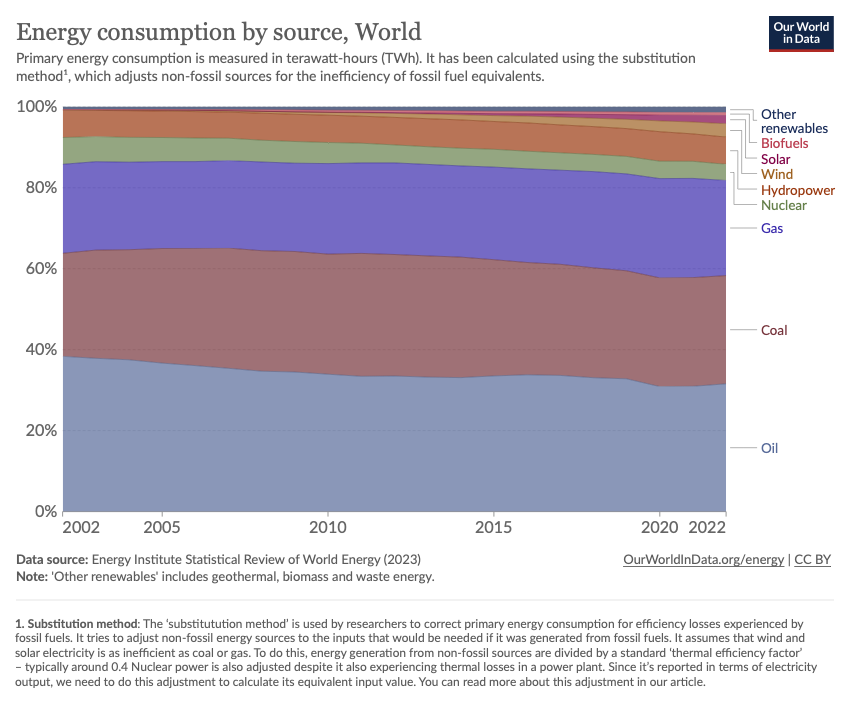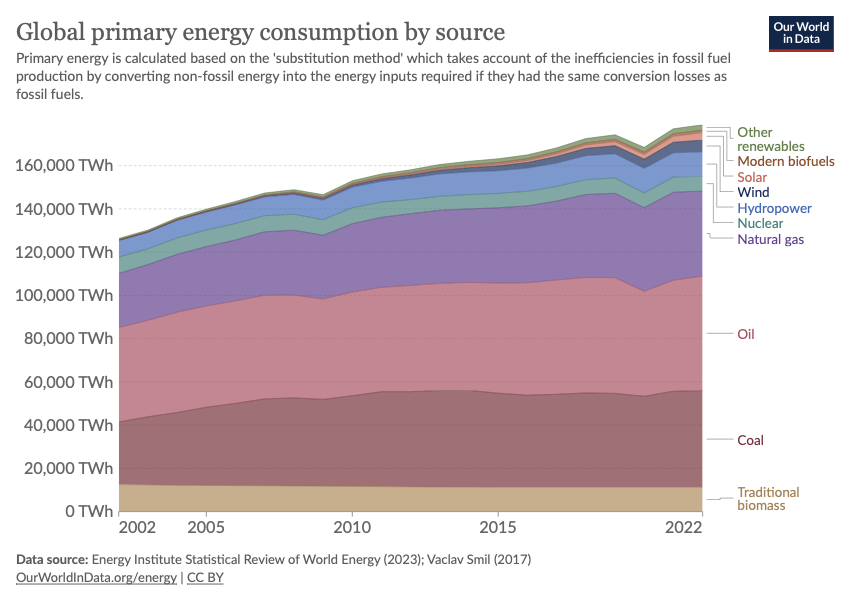Energy and the dilemma of delivery
by Nicholas Gould, Partner, and Rebecca Cook, Senior Associate
The world is using more energy each year, not less. While the rate of growth has slowed (now averaging around 1% to 2% per year), overall consumption continues to grow. Rebecca Cook and Nicholas Gould take a closer look at what can be done.
At the same time as energy use goes up, the world (generally) has committed to various climate change objectives, most notably the Paris Agreement, and widespread “net zero by 2050” targets which will require a significant decrease in the use of carbon emitting energy sources (coal, oil and natural gas) and an even more significant increase in the use of renewable and other low carbon energy sources.
That has not, as of yet, occurred. As depicted in the graphs below, consumption of carbon emitting energy sources remains dominant1 and all types of energy sources (both renewable and carbon emitting) are growing to fuel increasing demands.2


The challenge at hand, therefore, is ensuring that increased demands are met whilst also transitioning away from carbon emitting energy sources towards renewable and low carbon energy sources. While the significant pipeline of renewable projects worldwide will undeniably go some way to addressing this challenge, the question is whether it will be enough.
Understanding the baseload
In seeking to answer this question, it should not be overlooked that not all energy sources can be used in the same way.
Every functioning country requires a baseload of electricity, being the minimum amount of electric power needed to be supplied to the electrical grid at any given time. Baseload power must be supplied by constant and reliable sources of electricity, otherwise demand could exceed supply (i.e., there will be no electricity). Variable load energy, on the other hand, is where the load varies from time to time due to uncertain demands of consumers.
The difficulty is that baseload supplies are currently provided predominantly by carbon emitting energy sources (not renewable or low carbon) or nuclear energy (carbon neutral but not renewable and produce radioactive waste which is an environmental concern). This is because they are reliable and constant, and traditional sources of energy. Comparatively, all current renewable energy supplies (wind, hydro, solar) are variable – to varying degrees – so generally cannot provide the minimum baseload required because they are neither constant nor reliable (e.g., a dry year for hydro, light wind for wind or low sun for solar).
Given that renewable energy cannot currently provide the baseload (practically and cost effectively), yet the demand on the baseload continues to increase, it is difficult to see how renewable energy will overcome the demand-cum-climate predicament – at least in the short term while construction and technology catches up and renewables can become an effective source of baseload (or an effective substitute).
Impediments to delivery
For construction to “catch up” (i.e., reach a point where there are sufficient renewable energy sources to drastically reduce, and ultimately remove, the need for carbon emitting energy sources), several other impediments to the delivery of renewable energy projects will need to be addressed. Well-known examples include (albeit vary according to jurisdiction) the existing infrastructure, regulation, cost, access, market capability and capacity, storage, technology, market interruptions (Covid-19 and war), investment, and so on.
What is particularly interesting from a legal perspective is the emerging risks associated with renewable energy projects specifically and, as the volume of projects increase, the importance of considering and adequately dealing with those risks at the outset to ensure the successful delivery of such projects noting the required acceleration.
Given the prominent rise in offshore wind farm projects, some specific risks include:
- Interface risks: Typically, there are many interdependent packages of work, contractors and suppliers. For example, foundations and the wind turbine generator; foundations and cables;
,and supply, transportation and on/offshore installation of equipment. Also, the installation vessels, crew transport vessels and supply ships. Cooperation between different contractors is required. - Environmental Impact Assessment: Taking into account the environmental constraints and wildlife considerations.
- Allocation of seabed risk: Subsea cables, foundations, installation vessel (jack-up/fix legs to seabed).
- Adverse weather conditions: Wave heights, wind speeds, storms.
- Power curve test: Tests on completion to see if the wind turbine generator is working at its rated capacity.
- Marine warranty surveyor provisions: An independent insurance expert is required to approve certain offshore transport operations. Also, consider the scope of the insurance required.
- Design liability: The fitness for purpose obligation is onerous and is often diluted if the project delivery is split into multiple packages.
- Health and safety: Additional considerations arise because the work is offshore.
Construction contracts will need to be developed to ensure they are fit for purpose.
Where to from here?
While the future delivery of energy projects will be difficult (and, at times, painful) as energy demands continue to increase at a time where carbon emitting sources decrease and renewable resources increase dramatically, the future is certainly not “doomed”. To the contrary, the future is full of opportunities for those involved in renewable and low carbon energy projects as technology advances and collective intelligence combines to design and deliver new and better projects. The reality is that the transition will simply take time.
Until there is a solution to the ability for renewable or low carbon emitting energy sources to effectively provide the baseload, a possible middle ground for the short to medium term may be a combination of nuclear and wind (or possibly solar) with an ongoing need to address waste-to-energy.
Is fusion the future of renewable energy?
Further ahead, nuclear fusion may be the solution given it is entirely renewable (it uses easily attainable materials as compared to fission which uses the non-renewable material of uranium to generate reactions), can produce more energy than it consumes, is safe, and provides a sufficient baseload that is constant, thereby meeting all criterion. However, harnessing fusion energy comes with its challenges and remains a work in progress albeit with several recent advancements.
Such advancements include the International Thermonuclear Experimental Reactor (“ITER”) project currently under construction in Provence, France.3 ITER is the world’s largest international fusion experiment, conceived as the last experimental step to prove the feasibility of fusion as a large-scale and carbon-free source of energy. A consortium of nations (China, the European Union, Switzerland, India, Japan, Korea, Russia and the United States) are collaboratively designing and constructing ITER to advance science and technology to the point where demonstration fusion power plants can be designed.
Fusion energy was also included in the UN dialogue and deliberations for the first time in 2021 at COP26, marking a turning point for fusion as an integral part of the future of renewable energy and the wider global energy challenges.
Previous article | Next article
- 1. https://ourworldindata.org/grapher/energy-consumption-by-source-and-country?time=2002..latest. See also https://www.un.org/en/climatechange/raising-ambition/renewable-energy and https://www.iea.org/reports/world-energy-outlook-2022/key-findings.
- 2. https://ourworldindata.org/energy-production-consumption. See also www.iea.org/reports/world-energy-balances-overview/world,https://www.un.org/en/climatechange/raising-ambition/renewable-energy, https://www.iea.org/reports/global-energy-review-2021/renewablesand www.statista.com.
- 3. www.iter.org
